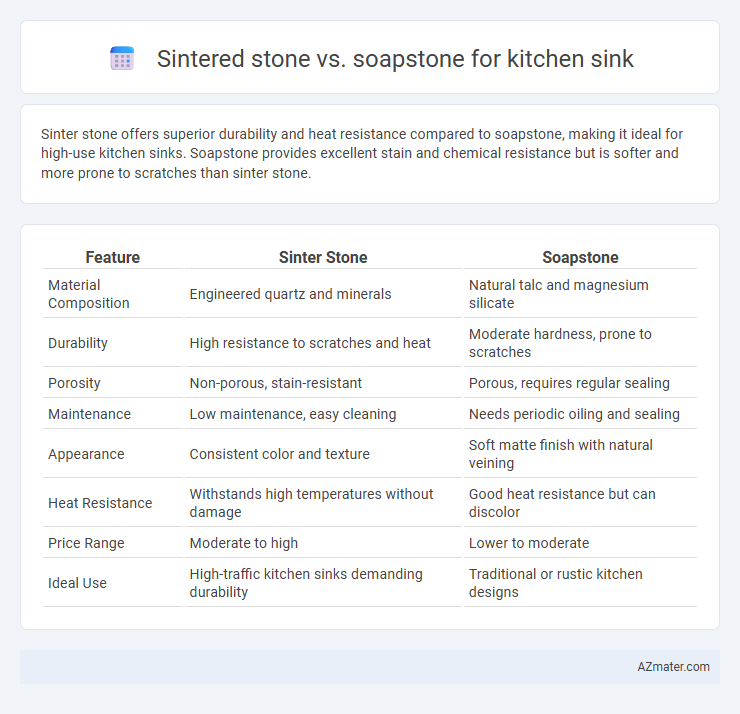Sinter stone offers superior durability and heat resistance compared to soapstone, making it ideal for high-use kitchen sinks. Soapstone provides excellent stain and chemical resistance but is softer and more prone to scratches than sinter stone.
Table of Comparison
| Feature | Sinter Stone | Soapstone |
|---|---|---|
| Material Composition | Engineered quartz and minerals | Natural talc and magnesium silicate |
| Durability | High resistance to scratches and heat | Moderate hardness, prone to scratches |
| Porosity | Non-porous, stain-resistant | Porous, requires regular sealing |
| Maintenance | Low maintenance, easy cleaning | Needs periodic oiling and sealing |
| Appearance | Consistent color and texture | Soft matte finish with natural veining |
| Heat Resistance | Withstands high temperatures without damage | Good heat resistance but can discolor |
| Price Range | Moderate to high | Lower to moderate |
| Ideal Use | High-traffic kitchen sinks demanding durability | Traditional or rustic kitchen designs |
Introduction to Sinter Stone and Soapstone Sinks
Sinter stone sinks are crafted from densely compacted mineral particles fused under high heat and pressure, resulting in a durable, non-porous surface resistant to stains and scratches. Soapstone sinks, composed mainly of talc and magnesium silicate, offer a soft, smooth texture with natural heat resistance and an ability to develop a unique patina over time. Both materials provide excellent options for kitchen sinks, balancing aesthetic appeal with functional durability.
Material Composition and Origins
Sinter stone, composed of finely ground natural minerals fused under high heat and pressure, originates from advanced sintering technology allowing customizable density and hardness. Soapstone, a metamorphic rock primarily made of talc, forms over millions of years through the alteration of dolomite and magnesium-rich minerals, predominantly found in regions like Brazil and the United States. The denser, engineered nature of sinter stone provides higher resistance to scratches and stains compared to the naturally softer, heat-retentive soapstone used traditionally in kitchen sinks.
Durability and Strength Comparison
Sinter stone exhibits superior durability and strength compared to soapstone, making it highly resistant to scratches, heat, and impact in kitchen sink applications. Manufactured through a high-pressure and temperature process, sinter stone offers enhanced density and hardness while maintaining a low porosity that reduces staining risks. Soapstone, although naturally heat-resistant and slightly softer, is more prone to scratches and dents, requiring regular maintenance to preserve its surface integrity.
Aesthetic Appeal and Design Options
Sinter stone offers a sleek, contemporary aesthetic with its smooth, uniform surface and availability in various colors, making it a popular choice for modern kitchen sinks. Soapstone provides a warm, natural look with unique veining and a matte finish that develops a rich patina over time, ideal for rustic or traditional kitchen designs. Both materials offer diverse design options, but sinter stone's versatility in shapes and custom colors often appeals more to those seeking a minimalist or high-end appearance.
Resistance to Stains, Scratches, and Chemicals
Sinter stone exhibits superior resistance to stains, scratches, and chemicals due to its dense, non-porous surface formed under extreme heat and pressure, making it highly durable for kitchen sink use. Soapstone offers moderate resistance, as its softer composition is more prone to scratches but naturally repels stains and withstands chemical corrosion because of its talc-rich mineral content. Choosing sinter stone ensures enhanced longevity and minimal maintenance, while soapstone provides a more natural aesthetic with basic protective qualities in a kitchen environment.
Maintenance and Cleaning Requirements
Sinter stone offers exceptional durability and resistance to stains, requiring minimal maintenance with just regular wiping using mild soap and water to keep its surface pristine. Soapstone, known for its natural soap-like texture, demands periodic oiling or seasoning to maintain its dark matte finish and can show fingerprints and watermarks more readily, necessitating frequent gentle cleaning. Both materials resist bacteria well, but sinter stone's non-porous quality makes it a more hygienic and low-maintenance option for busy kitchen sinks.
Cost and Budget Considerations
Sinter stone sinks typically have a higher upfront cost due to the advanced manufacturing process and superior durability, making them suitable for premium kitchen designs. Soapstone sinks are more budget-friendly, offering a natural, rustic aesthetic at a lower price point but may require more regular maintenance and sealing. Homeowners should weigh initial investment versus long-term care expenses to determine the best fit for their kitchen budget.
Installation Process and Flexibility
Sintered stone kitchen sinks offer a straightforward installation process due to their uniform thickness and pre-fabricated designs, allowing easy drop-in or undermount options. Soapstone sinks require skilled craftsmanship during installation because of their natural variance in thickness and density, often necessitating custom fitting and sealing. The flexibility of sintered stone enables versatile kitchen designs, while soapstone's rigidity limits modifications but provides exceptional durability and heat resistance.
Environmental Impact and Sustainability
Sintered stone sinks, made from natural minerals fused under high pressure and temperature, offer exceptional durability and resistance with minimal resource waste during production. Soapstone, a naturally occurring metamorphic rock, is extracted with low environmental impact and requires little energy for shaping, making it highly sustainable. Both materials are recyclable and long-lasting, but soapstone's biodegradable nature provides a slight edge in eco-friendliness for kitchen sink applications.
Final Verdict: Which Material is Best for Your Kitchen Sink?
Sinter stone offers superior durability and scratch resistance for kitchen sinks, making it ideal for high-traffic cooking environments, while soapstone provides excellent heat resistance and a naturally smooth, non-porous surface that resists stains and bacteria. Choosing between sinter stone and soapstone depends on your priorities: sinter stone is best for long-term toughness and minimal maintenance, whereas soapstone excels in aesthetic warmth and chemical resistance. For a kitchen sink combining resilience and timeless elegance, sinter stone generally emerges as the best overall material.

Infographic: Sinter stone vs Soapstone for Kitchen sink
 azmater.com
azmater.com